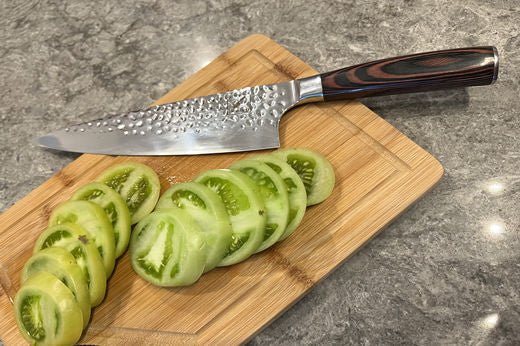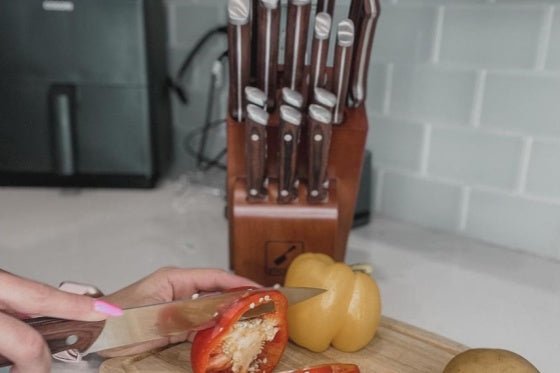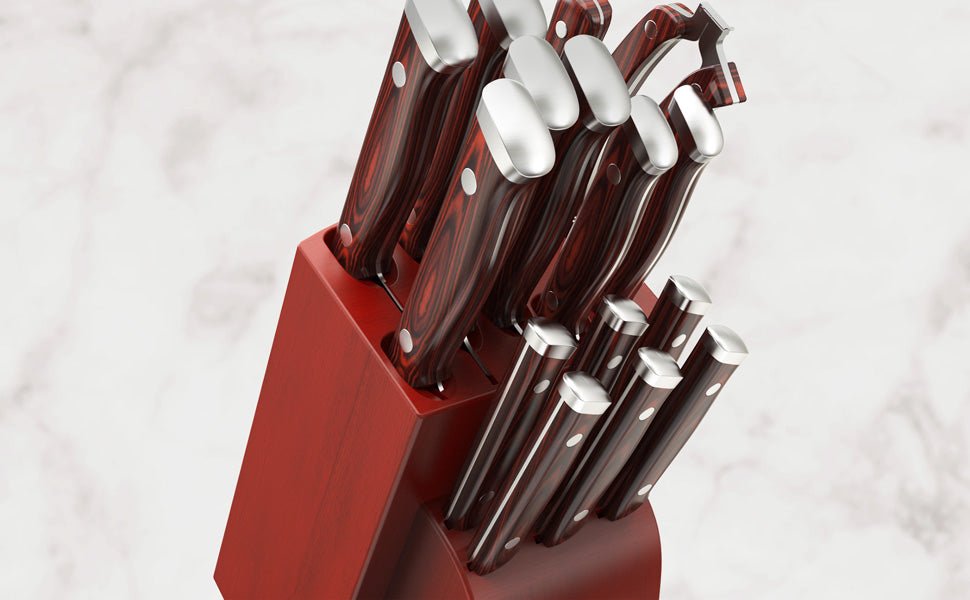TABLE OF CONTENTS
If you see a dish prepared by a world-renowned chef, you’ll notice that the plate is perfectly crafted. This is because professional chefs require the skills to perform the cut precisely. Mastering a few knife cuts will give you the confidence to take any recipe.
That said, proper knife skills are one of the finest arts in every chef’s arsenal. One of the important steps in the culinary world is mastering the batonnet cut. This skill makes a big difference in the ease of cooking.

What is A Batonnet Cut?
Batonnet is a French culinary term that refers to a small stick. It’s common in preparing potatoes, carrot sticks, crudités, stir-fries, and French fries. This is the same technique you’d use to make vegetable sticks for dips or as a side dish. It’s also perfect for smaller cuts like the mince, fine julienne, and small to medium dice.
To perform an accurate batonnet cut, you must have the right ingredients. The two common foods are carrots and potatoes.
What Size Cuts are batonnet?
Batonnet cuts take center stage. These cuts, measuring approximately ¼ inch by ¼ inch by 2-2 ½ inches (or sometimes ½ inch by ½ inch by 2 ½-3 inches), are a testament to the artistry of knife skills.

Why Batonnet?
The batonnet technique gives you a linear appeal when serving food. It comes in handy when serving your food in salads and skewers. Here are the reasons why you should choose the batonnet technique:
Beautiful presentation
A proper batonnet enhances your food presentation. It’s perfect for making garnishes and serving roasting vegetables. If you’re serving salads, you can place a nice slice of dish for added effect.
Besides presentation, you get a better mouthful. This explains why the cutting technique is used in a lot of snacks and appetizers. It’s more of a three-dimensional look.
Easy cooking
Preparing your vegetables with a batonnet takes time. When you have uniform sizes, you can submerge the veggies in the oil when sautéing. It’s a surefire way to cook food evenly without worrying about the ingredients.
Uniform sizes
When you cut ingredients of the same size, everything will cook at the same speed. Once you master the art, you’ll get a lot of fun. You’ll enjoy the rough edges, skin, and loop-sized curves.
Easy storage
If you plan to serve your food on skewers, a batonnet cut is a great option. When you have a set of ingredients, you can buy in bulk without worrying about how you’ll keep the cut veggies.

Essential Tools for Batonnet Cutting
Achieving the ideal dimensions of batonnet cuts requires not only a keen eye but also the right tools—a sharp chef's knife or santoku knife and a stable cutting board.
The shape of the knife you use will affect the outcome of your cuts. The last thing you want is incorrect or jagged cuts. A typical 8-inch chef’s knife offers the best results. You should stay away from knives that can result in accidents. To ensure the perfect cut, you should invest in a chef’s knife that is 6 to 14 inches long. Understanding the parts of a knife can help you grip it correctly, improve control, and make precise Batonnet cuts effortlessly.
To slice and dice with ease, you should hold the knife comfortably with your thumb, and the other three fingers are wrapped securely on the handle. The other hand should anchor the vegetables.
Crafted with German HC stainless steel, this blade is a culinary masterpiece. Its razor-sharp edge effortlessly tackles chopping, slicing, dicing, and mincing. The ergonomic design ensures a comfortable grip, making it a chef's trusted companion.
Equipped with the hollow edge design, this 7-inch santoku chef knife adds gap between the knife blade and the material being cut, keeping things from sticking to the knife blade, special for slicing, dicing, and mincing.

A Bowl
You need a bowl that is wide enough to hold your contents and keep the pieces inside. Perhaps, you should consider a bowl with straight sides to make the portioning easier. You can also use a plate with a non-porous surface or a clean counter space.
Cutting Board
A quality board guarantees a clean and accurate cut. Unlike the plastic counterparts, a wooden material won’t dull. The best board is easier on knives and should fit well with the aesthetics of your kitchen. Your cutting board should lay flat on the counter.
From precise batonnet cuts to everyday prep, explore our full selection of knives and accessories (excluding cookware) in the All Products—No Cookware Sets collection.
Know more knife sets for batonnet cut.
Step-By-Step Guide on How to Make a Batonnet Cut
To ensure the best outcome with the cuts, there’s a specific way this should be done. You should also follow the step-by-step process.
As with any other cutting technique, you should wash your hands and ensure the chopping board is not moist. Next, wash all the ingredients thoroughly.
Hold the knife with the dominant hand such that the pointing finger is at the top of the blade. The grip will give you more control, especially if you’re getting used to this cutting technique. You should use the other hand to anchor the vegetables.
You can now cut in a smooth and gentle motion – not brutal force.
Step 1: Preparation
Begin with fresh, washed vegetables or fruits. Ensure your cutting board is stable and your knife sharp.
Step 2: Cut Crosswise 2.5-inch Pieces
Once the long sticks are ready, it’s easy to perform the dicing across the length of the initial cut. Proper cutting skills require extensive experience. It takes practice for a chef to know how to be as precise as possible on each cut.
Step 3: Take each piece and cut ¼-inch
Leaving you with rectangular pieces. You can cut each rectangle individually or stack them together. In the end, you’ll have a good amount of batonnet ingredients ready for eating.
Consistency
Maintain consistency in size for even cooking and an appealing presentation.
Practice
Perfecting the batonnet cut may take practice, but the results are worth it. Elevate your culinary creations with this technique, ideal for various ingredients.

How to Batonnet A Carrot
If you need the perfect cut, you must have the right knife skills. You should choose carrots that are a few inches thick to get the most of your batonnet.
The first step is to wash the carrots and pat them dry. This is a step that you can’t miss since the dirt can interfere with the precision of the cuts. After that, peel the skin and any bruised parts.
Cut the carrot crosswise 2 to 2.5 inches. You may want to divide before squaring off – the bottom part tends to yield more pieces. Another strategy is to cut the carrot in the middle, with the two pieces measuring 3 inches.
Make sure the sizes can easily grip and are comfortable working with. If you want smaller sticks, you can cut the carrot into two-thirds.
But here is the catch – since the carrots are round, you should roll them to create a stable base. This will prevent the knife from slipping. You can repeat to trim the thin slices. Now that you have a perfectly squared carrot, you can hone your knife skills.
Cut the carrot into uniform planks of ¼ inches thick. You now have a nice pile of well-cut carrot batonnets.

How to Batonnet A Potato
You can batonnet a potato for deep-frying or seasoning.
Peel the potato with a vegetable peeler
Start by giving your potato a good scrub and peel them. You can set down a plastic paper bag so that you can discard it when done.
Squaring lengthwise
You should set the broad side down with the knuckles taking care of the fingertips and thumb. Make sure it’s enough to get off to the flat surface. Next, turn the other side and flat the surface. After that, turn the third flat surface and keep the 90-degree angle. Do the same to the fourth side. You will end up with rounded ends.
If you’re a beginner, this is a tricky part. You can try to square it without wasting the potato. When you cut into stabs, it prevents excess sliding.
Cut the rectangle into ¼-inch planks
Start by slicing ¼-inch of potato, turning the potato sticks, and cutting crosswise down to 2 to 2.5 inches. Continue cutting ¼-inch thick potato keeping 90-degree angles. At the end of the process, you should ensure the batonnet is ¼-inch by 2 or 3 inches.
If you’re making the cuts for French fries, you should submerge the batonnets in water. This helps to remove the excess starch. You can keep them there for a couple of hours until you’re ready to use them.
FAQs
Can you Batonnet cut any type of vegetable?
Certainly, the Batonnet cut is a versatile technique suitable for various vegetables. Its precision in creating uniform sticks makes it applicable to many, but the ease may vary based on the vegetable's texture and shape. Practice and adaptability are key to mastering this culinary art.
What are the primary uses of Batonnet-cut vegetables in cooking?
Their primary uses include adding texture and uniformity to salads, providing a consistent base for stir-fries, and enhancing the presentation of side dishes. Batonnet-cut vegetables shine in recipes where even cooking times and a refined appearance are crucial.
Whether they're starring in a colorful medley of veggies or serving as elegant garnishes, Batonnet-cut vegetables elevate the art of cooking, ensuring that each bite is a harmonious blend of flavors and textures.
How does a Batonnet Cut differ from a Julienne Cut?
While Batonnet and Julienne cuts may seem similar, there's a distinction. Batonnet pieces are slightly larger, measuring about 1/4 inch by 1/4 inch by 2-2 1/2 inches, whereas Julienne pieces are finer at 1/8 inch by 1/8 inch by 2 inches. Understanding this difference is crucial for precision in your culinary endeavors.

What are common mistakes to avoid when performing Batonnet cuts?
To achieve those flawless sticks of vegetables, avoid these common blunders:
Wrong Knife Choice: Using the wrong knife can result in uneven cuts. Opt for a sharp chef's knife for a solid batonnet cut.
Inconsistent Dimensions: Batonnet cuts should be uniform. Inconsistent sizing can lead to uneven cooking.
Lack of Preparation: Failure to wash and dry vegetables can affect the quality of the cut. Dirt can interfere with clean, precise slices.
Incorrect Technique: Not squaring off the vegetable before cutting can result in irregular sticks. Follow proper technique to achieve uniform batonnet cuts.
Neglecting Safety: Batonnet cuts involve sharp knives. Keep your hands and cutting board dry to prevent accidents, and use proper knife-handling techniques.
Rushing the Process: Precision takes time. Rushing can lead to mistakes. Take it slow and focus on accuracy for perfect batonnet cuts.
Final Thoughts
Proper knife skills are essential in preparing your dishes – they also give you more confidence. The batonnet technique will ensure you have uniform pieces such that your dishes will look appealing. Whether you want to make oven-baked sweet fries or you need tasty glazed carrots, you should master the batonnet technique.
Once you harness your skills, you can cook almost any dish you can think of. After you become a pro, you can add your flair. For those looking to upgrade their kitchen tools, check out the latest Imarku discount codes to get the best value on premium knives and cookware.






















Leave a comment
All comments are moderated before being published.
This site is protected by hCaptcha and the hCaptcha Privacy Policy and Terms of Service apply.